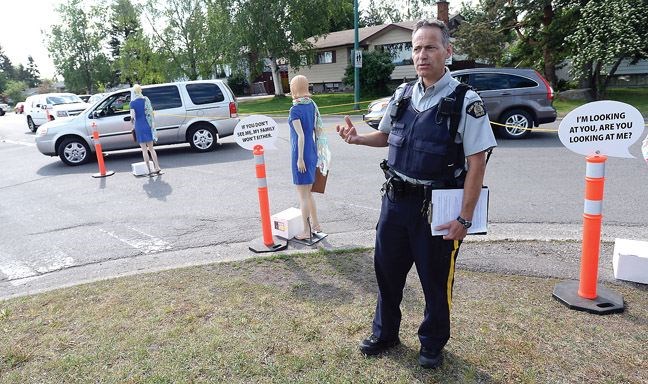Turning left at an intersection with traffic coming the other way is one of the most common causes of drivers running into pedestrians, but there are steps both parties can take to avoid what can lead to a tragic consequence.
That was the message from a Prince George RCMP officer who, with the help of mannequins, signs, rope and two vehicles, took local media through a demonstration Thursday at the corner of Kerry Street and Davie Avenue of what commonly happens in such a scenario.
Using yellow ropes to show the driver's line of vision, Cst. Bryan Dunnett said challenges the person behind the wheel must face include losing sight of the pedestrian in a blind spot, notably when a vehicle's pillar is blocking the view. Further complicating matters is estimating the speed of oncoming traffic and where the pedestrian is in the crosswalk.
"Drivers are required to yield to the right-of-way to pedestrians in crosswalks and in intersections," Dunnett said, adding that wherever a sidewalk ends at a roadway and continues on the other side is defined as an intersection.
He urged drivers to refrain from texting and talking on cellphones while in motion and to drive to conditions. If there are potholes, slow down, Dunnett said, even if it means going just 30 km/h.
Pedestrians can also take measures to protect themselves starting with making sure the driver has stopped before venturing beyond the sidewalk.
"We don't want pedestrians to assume that as soon as they step off that curb that all the vehicles are going to stop," Dunnett said. "These drivers may be high risk drivers, they may be distracted... you don't know if they're a good driver, a bad driver, a high risk driver, you don't know if they're an impaired driver. That's a lot of trust for someone stepping out onto a roadway not knowing what the condition of the driver is."
Distracted walkers and runners can also be a concern. Dunnett said police see a lot of pedestrians preoccupied with their smartphones or music players and not looking where they're going. Likewise, earbuds can block out the sound of oncoming traffic.
"We can't recommend enough to maintain eye contact (with the driver)," Dunnett added. "That's one of the indicators for the pedestrians."
Particularly at night, wear bright and even reflective clothing and, if you're in a rural area where there are no streetlights, carry a flashlight, Dunnett suggested. He noted that at night, a pedestrian's eyesight is usually better adjusted to the darkness than a driver's.
"The driver's eyes are competing with oncoming headlights, competing with streetlights, they're competing with the illumination inside the dash of the vehicle," Dunnett said. "Their eyes are constantly adjusting to the light, dark, light, dark, so a pedestrian is going to see a driver before a driver sees a pedestrian."
Impairment can also affect a pedestrian's judgment.
"It's not against the law to go out and have a good time, have a night out, have a few drinks," Dunnett said. "But be vigilant. Don't cut corners, don't do a jaywalk while you're out for a night on the town."
Dunnett agreed that sticking a hand out to notify a driver that you want to cross a street is worthwhile but you must still wait until the driver had stopped before
crossing.
He also urged walkers and runners to be extra careful around larger vehicles, like heavy duty pickups and tractor-trailers, because the driver's sight lines may not be as good.
The detachment's traffic services section will be keeping a close eye on drivers and pedestrians alike in the coming weeks to prevent another fatality. The primary offences are jaywalking for pedestrians and failing to yield for drivers.
Five pedestrians have died this year when they were hit by vehicles "and we don't want any more," Dunnett said.



